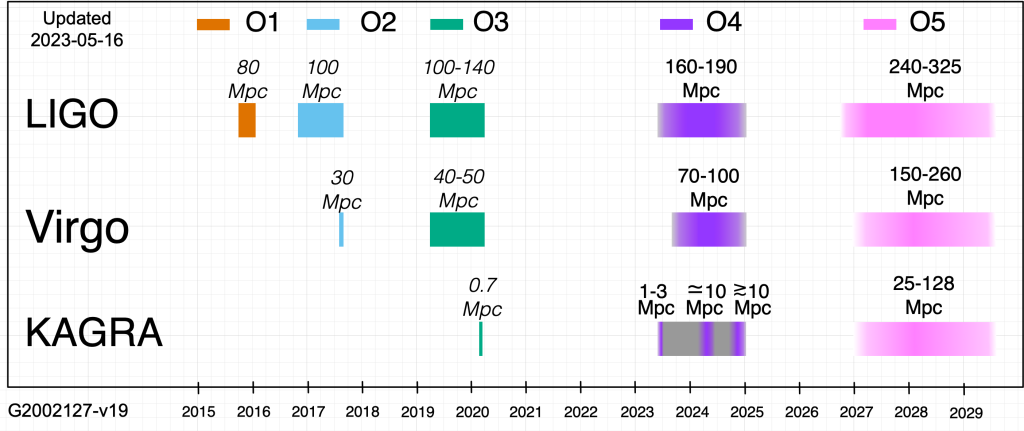LIGO-Virgo-KAGRA Runs
Advanced Virgo, in coordination with the other detectors in the global LIGO- Virgo- KAGRA (LVK) network, alternates between observation periods (or ‘runs’) during which the detectors are taking data, and phases of improvements, in which technical upgrades are done to the detectors to gain a better sensitivity. Every upgrade phase ends with a “commissioning” phase, in which the best functioning point of the detector with the upgraded parts is achieved so that the new observing period can start with a significantly improved sensitivity with respect to the previous operation.

There have been three observing runs of the Advanced detectors until now. During the first one (O1), Advanced Virgo was still in the upgrade phase and the first detection of gravitational waves was achieved, on the 14th of September, 2015. The signal is known as GW150914. Virgo joined the LIGO detectors for the final month of the second observing run (O2) in August 2017 and achieved its first detection shortly after, on the 14th of August 2017.
Just three days later, the global network of the three Advanced detectors (the two LIGOs and Virgo) detected their first neutron star merger, GW170817. The combination of data from the three detectors in the network allowed a precise localization of the source in the sky, and that in turn made it possible for telescopes across the electromagnetic spectrum to be oriented towards that event and hence observe it in the following hours and days. This started a new era of exploration of the cosmos through multiple “messengers”, the so-called “Multimessenger astronomy” with gravitational waves.
The third LIGO-Virgo Observing Run (“O3”) lasted 11 months: a first six-month period (O3a, from April 1st to October 1st, 2019) and a second five-month period (O3b, from November 1st, 2019 to March 27th, 2020), interleaved by a 1-month period dedicated to detector improvements (the commissioning break, in October 2019). O3 has been the first long data-taking period for the Advanced Virgo detector.
At the end of the three observing runs, 90 gravitational wave events have been reported, most of them black hole-black hole mergers, but also neutron star-neutron star mergers and a handful of mixed black hole-neutron star mergers. All of these events are collected in catalogs: the most complete one is the 3rd Gravitational Wave Transient Catalog (called GWTC-3).
Observing run O4 is scheduled to cover 2023.